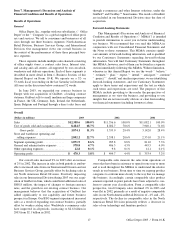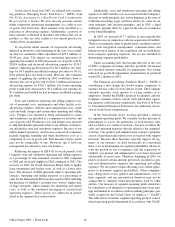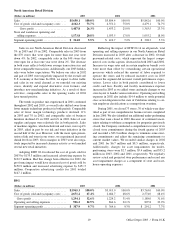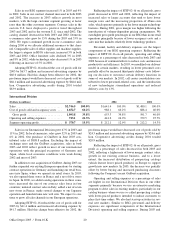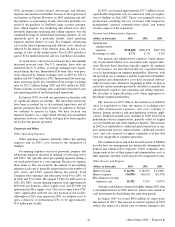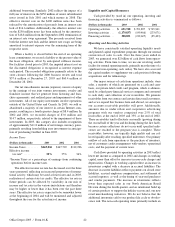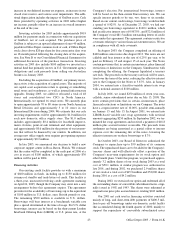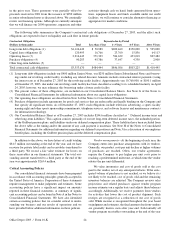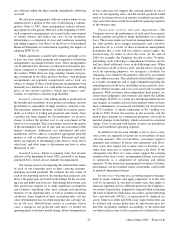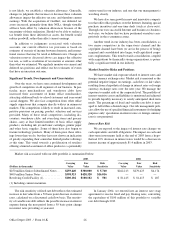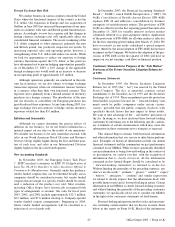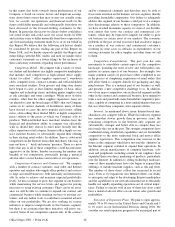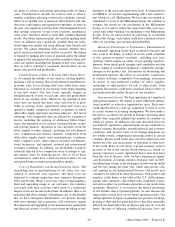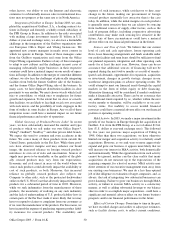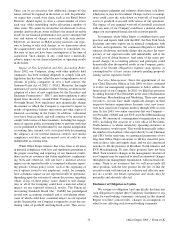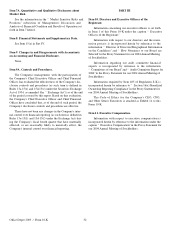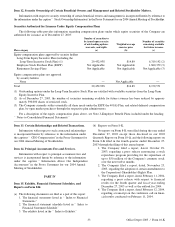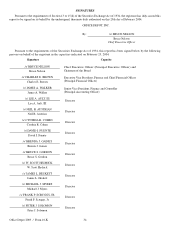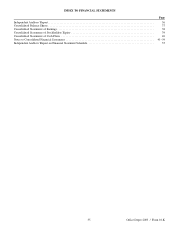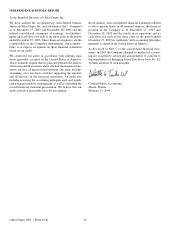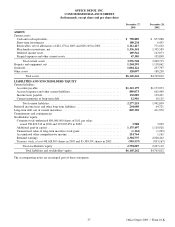Office Depot 2003 Annual Report Download - page 29
Download and view the complete annual report
Please find page 29 of the 2003 Office Depot annual report below. You can navigate through the pages in the report by either clicking on the pages listed below, or by using the keyword search tool below to find specific information within the annual report.Foreign Exchange Rate Risk
We conduct business in various countries outside the United
States where the functional currency of the country is not the
U.S. dollar. Our expansion in Europe and our acquisition of
Guilbert in June 2003 has increased the proportion of our oper-
ations in countries with euro and British pound functional cur-
rencies. Accordingly, we now face a greater risk that changes in
foreign currency exchange rates will significantly affect our
consolidated financial statements. The recent weakening of the
U.S. dollar compared to other currencies, primarily the euro
and British pound, has positively impacted our results by
increasing reported sales and operating profit; however, a
strengthening of the U.S. dollar will reduce our results. While
we look for opportunities to reduce our exposure to foreign
currency fluctuation against the U.S. dollar, at this point we
have determined not to pursue hedging opportunities generally.
As of December 27, 2003, a 10% change in the applicable
foreign exchange rates would result in an increase or decrease
in our operating profit of approximately $17 million.
Although operations generally are conducted in the rele-
vant local currency, we are also subject to foreign exchange
transaction exposure when our subsidiaries transact business
in a currency other than their own functional currency. This
exposure arises primarily from a limited amount of inventory
purchases in a foreign currency. The introduction of the euro
and our decision to consolidate our European purchases has
greatly reduced these exposures. At any time during 2003, for-
eign exchange forward contracts to hedge certain inventory
exposures totaled less than $51 million.
Inflation and Seasonality
Although we cannot determine the precise effects of
inflation on our business, we do not believe inflation has a
material impact on our sales or the results of our operations.
We consider our business to be only somewhat seasonal, with
sales in our North American Retail Division and Business
Services Group slightly higher during the first and third quar-
ters of each year, and sales in our International Division
slightly higher in the first and fourth quarters.
New Accounting Standards
In November 2003, the Emerging Issues Task Force
(“ EITF”) reached a consensus on EITF 03-10,Application of
Issue No. 02-16 by Resellers to Sales Incentives Offered to
Consumers by Manufacturers. Generally under this guidance,
vendor funded coupons that can be redeemed broadly across
companies should be considered revenue, but vendor funded
coupons that are unique to a specific retailer should be consid-
ered a reduction of the product cost sold. Most retailers,
including Office Depot, have historically recognized both
types of arrangements as revenue. Our sales for fiscal years
2003, 2002, and 2001 include approximately $12.3 million,
$4.5 million, and $7.6 million relating to Company-specific
vendor funded coupon arrangements. Beginning in 2004,
future vendor funded arrangements will be classified as a
reduction of cost of goods sold.
In December 2003, the Financial Accounting Standards
Board (“ FASB”) issued FASB Interpretation (“ FIN”) No.
46(R), Consolidation of Variable Interest Entities. FIN 46(R)
replaces FIN 46 and addresses consolidation by business
enterprises of variable interest entities. The provisions of FIN
46(R) are effective for the first reporting period that ends after
December 15, 2003 for variable interests in those entities
commonly referred to as special-purpose entities. Application
of the provisions of FIN 46(R) for all other entities is effective
for the first reporting period ending after March 15, 2004. We
have no interest in any entity considered a special purpose
entity; therefore, the initial adoption of FIN 46(R) did not have
an impact on the Company. We believe the adoption of the pro-
visions of FIN 46(R) in the first quarter of 2004 will have no
impact on our net earnings, cash flows or financial position.
Cautionary Statements for Purposes of the “Safe Harbor”
Provisions of the Private Securities Litigation Reform Act
of 1995
Cautionary Statements
In December 1995, the Private Securities Litigation
Reform Act of 1995 (the “ Act”) was enacted by the United
States Congress. The Act, as amended, contains certain
amendments to the Securities Act of 1933 and the Securities
Exchange Act of 1934. These amendments provide protection
from liability in private lawsuits for “ forward-looking” state-
ments made by public companies under certain circum-
stances, provided that the public company discloses with
specificity the risk factors that may impact its future results.
We want to take advantage of the “ safe harbor” provisions of
the Act. In doing so, we have disclosed these forward-looking
statements by informing you in the following specific caution-
ary statements of certain circumstances which may cause the
information in these statements not to transpire as expected.
This Annual Report contains both historical information
and other information that you can use to infer future perform-
ance. Examples of historical information include our annual
financial statements and the commentary on past performance
contained in our MD&A. While we have specifically identified
certain information as being forward-looking in the context of
its presentation, we caution you that, with the exception of
information that is clearly historical, all the information
contained in this Annual Report should be considered to be
“ forward-looking statements” as referred to in the Act.
Without limiting the generality of the preceding sentence, any
time we use the words “ estimate,”“ project,”“ intend,”“ expect,”
“ believe,” “ anticipate,” “ continue” and similar expressions,
we intend to clearly express that the information deals with
possible future events and is forward-looking in nature. Certain
information in our MD&A is clearly forward-looking in nature,
and without limiting the generality of the preceding cautionary
statements, we specifically advise you to consider our MD&A
in the light of the cautionary statements set forth herein.
Forward-looking information involves risks and uncertain-
ties, including certain matters that we discuss in more detail
below in this report on Form 10-K. Much of the information
27 Office Depot 2003 / Form 10-K


